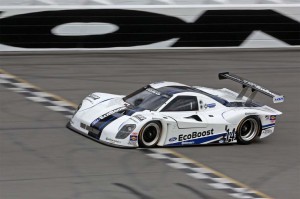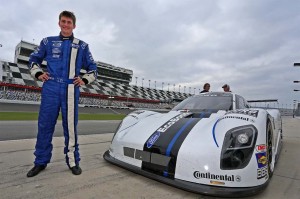Ford has done an admirable job of establishing the EcoBoost name in the market as shorthand for the maker’s latest fuel-saving powertrain technology. So, some folks might be excused for getting confused by the news that a Ford EcoBoost-powered racer has just set a new speed record at Florida’s legendary Daytona speedway.
A prototype race car using a specially modified 3.5-liter EcoBoost V-6 turned in a single lap speed record of 222.971 miles per hour on the big Daytona oval, besting a 26-year-old record set by NASCAR champ Bill Elliott while qualifying for the 1987 Daytona 500 – coincidentally in a Ford Thunderbird.
Ford recently announced plans to develop an EcoBoost-powered racer to demonstrate that the technology isn’t solely meant to deliver good mileage but can also be fun to drive.
And Ford isn’t alone. Mazda dominated the Grand Am GX series – after addressing some early problems – with a race car powered by a SkyActiv-D diesel, an engine the Japanese maker claims is only a modestly modified version of the “oil burner” that will appear in the Mazda6 sedan early next year.
Meanwhile, a number of makers are looking to take their battery-car technologies racing to demonstrate the fun side of electric propulsion.
(Click Hereto find out why Mazda is delaying launch of the SkyActiv-D diesel by 6 months.)
Ford’s effort to show the flexibility of EcoBoost is no surprise considering how much of an investment it has made in the technology. At its heart, EcoBoost borrows some of the technologies used to make diesels so popular in Europe – notably high-pressure fuel injection and advanced turbocharging. The result is a powertrain that can deliver markedly better fuel economy without sacrificing power or performance, the maker claims.
With an expanding range of engines from a modest 1.0-liter 3-cylinder used in the little Fiesta up to the 3.5-liter V-6 offered in the big F-Series pickups, Ford is now selling EcoBoost by the millions and expects to soon make at least one of the engines optional in about 85% of its product lines.
(Sales of EcoBoost and other turbocharged engines expected to soar in coming years. Click Here for the story.)
It’s also using a modified 3.5-liter EcoBoost to power a closed prototype race car that will be entered in the new Tudor United SportsCar Championship which next year combines the old American LeMans and Grand Am race series.
“It was a challenging day,” said driver Colin Braun of his record run in the EcoBoost Daytona Prototype. “There was a lot of work put in by a lot of people to accomplish these records. The power in the new EcoBoost engine was incredible, and it was amazing how fast it came up to speed on the runs.”
(VW planning to go all turbo; Ford could follow. Click Here for more.)
At nearly 223 mph, Braun lapped the Daytona circuit in just 40.364 seconds.
And he wound up setting several other records before pulling back into the pits, including a world speed record for 10 miles from a standing start, at an average 210.01 mph, as well as a 10 kilometer record of 202.438 mph.
That is, of course, pending certification by world record body FIA.
Of course, the real test will come next year when the Roush Yates-build Daytona Prototype has to go up against a field of competitors and doesn’t get to lap the track all on its own.



The good era of small turbo engines is upon us but history has shown that when you ask a small engine to do the work of a large engine, wear increases proportionately. As such engine life will be reduced and increased maintenance will be required. Consumers will end up paying the price for the technical ignorance and pandering of Obama and the EPA.
As you pointed out, asking a small engine to do more work increases wear and reduces engine life. And, as you also pointed out, this is an historical fact and is unrelated to whoever occupies the White House. The EPA is tasked with protecting the environment; one way that they have chosen to do that is to reduce auto emissions. They were working on that before Obama took office, and they’ll likely be working on that long after he’s gone. So blaming him is neither constructive or appropriate.
And there are only so many ways that an auto manufacturer can accomplish the objective to lower emissions, not least among them being an increase in fuel efficiency. History has shown us that manufacturers are reluctant to make the necessary investments in research and development to accomplish objectives that benefit everyone without a government mandate which assures all manufacturers that the playing field will be level. The same thing has been true of safety enhancements in automobiles, which would likely have come about much more slowly, if at all, without government influence to develop airbags, improve crash survivability, etc.
Consumers wind up “paying the price” no matter what the EPA does. If fuel efficiency improves, they cars cost more to purchase, but less to operate on a daily basis; if they become less reliable over time, then manufacturers will innovate improvements in materials technology and design, or they will lose sales to companies who provide a better-engineered solution. That’s no different today than it was thirty or fifty years ago, and “technical ignorance and pandering of Obama and the EPA” has nothing to do with it.
One of the more interesting facts emerging from various consumer surveys is that even as high tech glitches become increasingly common, traditional mechanical problems, especially engine and transmission failures, have all but vanished. One only has to look to Europe where turbo diesels are half the market and turbos are increasingly common on the gas side to see that modern blower technology is vastly superior – and more reliable – than what we knew even a decade ago.
Paul A. Eisenstein
Publisher, TheDetroitBureau.com